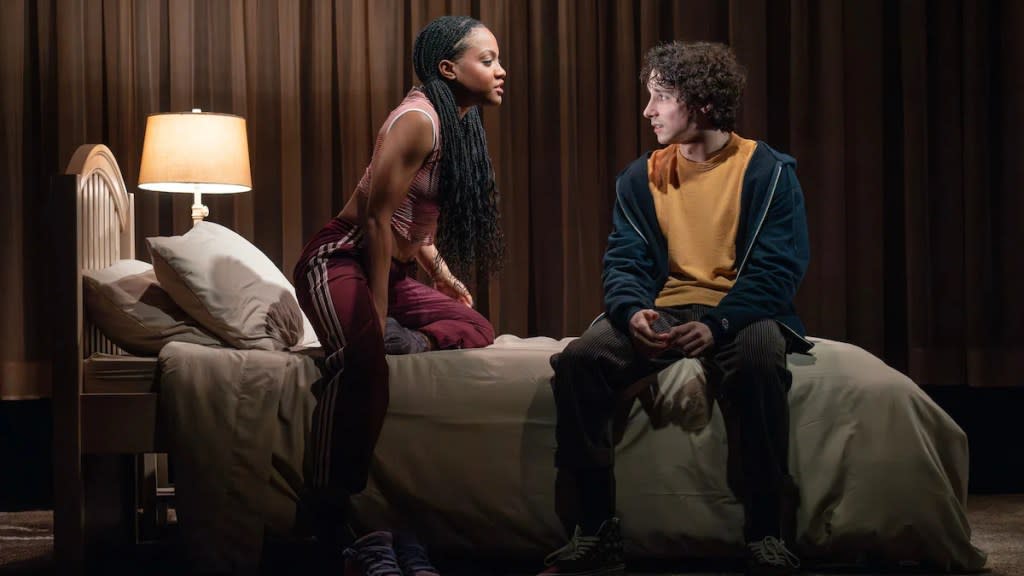‘Jonah’ Off Broadway Review: How a Fantasy Becomes Reality if You Write About It

Leaving the theater where the new play “Jonah” had just performed, a couple behind me barely waited for the curtain to come down to start talking about what they’d just seen.
“So the three male characters were the woman’s fantasies,” he proclaimed with assurance.
“No!” she replied. “They were all real.”
My date for the evening and I agreed on yet a third interpretation. As we saw the play, two of the male characters are real, and one of them is a fantasy. Of course, in the theater, everybody on stage is a figment of the playwright’s imagination, and it’s telling that Rachel Bonds, the author of “Jonah,” has made her lead character, Ana (Gabby Beans), a writer who has written either a memoir or an autobiographical novel, and she is working on a sophomore effort. Her imagination is her salvation. What’s real and what’s not, and how a brutal reality both triggers Ana’s crisis of intimacy and leads her to create a sexual fantasy is very much what “Jonah” is about. At least for me. The description of this play on Bonds’ website gives a quite different interpretation.
The initially head-scratching but always fascinating new play titled “Jonah” had its world premiere Thursday at Roundabout’s Laura Pels Theatre.
Since “Jonah” is open to lots of interpretations, obviously, it’s not an easy play to review. Either I’ll give away too much of the puzzle or I’ll make a fool of myself by exposing what I missed or completely got wrong. Here’s one sure-fire takeaway: “Jonah” is directed by Danya Taymor, who has an unerring knack for picking and directing only the very best new works by young writers. Especially alluring is how Taymor sets Ana apart from the three male characters, who, at different points in this character’s journey, interact with her – or just appear as a figment of her imagination.
There’s a purposeful exaggeration in the performances of the three male actors that puts them in sharp contrast to Beans’ far more subtle and nuanced delivery. Her Ana appears alternately flirtatious, edgy and dismissive. Like most of us, she shape-shifts depending on who’s sharing the room with her.
Regarding the men on stage, Hagan Oliveras brings a benign loopiness to the role of a high school stalker. (He’s the Jonah of the title.) Samuel Henry Levine exudes a brutish familiarity as the man who both triggers Ana’s crisis and rescues her. And John Zdrojeski manages to be nice to the point of repulsive as the too-available guy-next-door who no woman would look at once, much less invite into her room. He just kind of barges in, but with obnoxious charm.
Speaking of rooms, “Jonah” takes place in a teenage girl’s bed room, her dorm room, and a living space at some artist’s retreat. Those were the three locales I was able to identify, even though Wilson Chin’s set design resembles none of those places despite containing both a desk and a bed. I found myself wondering at one point how a college coed could have possibly published a successful book when I realized, finally, that Bonds is not telling her story in chronological order. This realization came to me well over the halfway point in this 100-minute play. Until its penultimate scene, not much in “Jonah” seems to connect to what just happened or what will next happen.
In other words, watching “Jonah” is often an exercise in being confused, an experiment in disorientation that is never less than very absorbing thanks to Beans’ riveting performance – she never leaves the stage – and Bonds’ extraordinary gift for language.
It’s easy to settle into each of the play’s many scenes and revel in the initially witty dialogue that slowly turns downright acrid.
The post ‘Jonah’ Off Broadway Review: How a Fantasy Becomes Reality if You Write About It appeared first on TheWrap.

